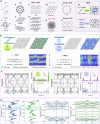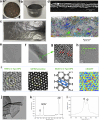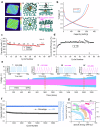Van-der-Waals-forces-modulated graphene-P-phenyl-graphene carbon allotropes
- PMID: 41238558
- PMCID: PMC12618698
- DOI: 10.1038/s41467-025-64971-1
Van-der-Waals-forces-modulated graphene-P-phenyl-graphene carbon allotropes
Abstract
Graphene has received much attention due to its monoatomic, unique two-dimensional structure, which results in remarkable mechanical, physical, and electrical properties. However, synthesizing high-quality graphene-based composites with high conductivity and ionic mobility remains challenging. Here, we report an allotrope to the nanocarbon family, Graphene-P-phenyl-Graphene, synthesized by inserting π-π-conjugated p-phenyls between graphene layers and connecting them via C-C σ bonds. Graphene-P-phenyl-Graphene is thermally and dynamically stable, as verified by density functional theory and molecular dynamics, and can be produced at kilogram scale. The p-phenyl bridges swell the layer spacing from ~0.34 to ~0.56 nm, reducing van der Waals forces and enhancing electron delocalization. Electrons in these separated graphene layers benefit from low mass and efficient 3D screening of charge scattering, resulting in high Hall mobility (10,000-13,000 cm² V⁻¹ s⁻¹) in freestanding films. The expanded spacing also enables decoupling of layer electrons and rapid ion storage and transport-even for large ions. For example, potassium-ion batteries using Graphene-P-phenyl-Graphene exhibit high reversible capacity, long-term stability, and high charge-discharge rates. Graphene-P-phenyl-Graphene holds promise for large-scale, portable, high-performance electronics with energy storage capabilities.
© 2025. The Author(s).
Conflict of interest statement
Competing interests: The authors declare no competing interests.
Figures




References
-
- Kroto, H. W., Heath, J. R., O’Brien, S. C., Curl, R. F. & Smalley, R. E. C60: Buckminsterfullerene. Nature318, 162–163 (1985).
-
- Iijima, S. & Ichihashi, T. Single-shell carbon nanotubes of 1-nm diameter. Nature363, 603–605 (1993).
-
- Novoselov, K. S. et al. Electric field effect in atomically thin carbon films. Science306, 666–669 (2004). - PubMed
-
- Kaiser, K. et al. An sp-hybridized molecular carbon allotrope, cyclo[18]carbon. Science365, 1299–1301 (2019). - PubMed
-
- Pan, F. et al. Long-range ordered porous carbons produced from C60. Nature614, 95–101 (2023). - PubMed
Grants and funding
LinkOut - more resources
Full Text Sources
Research Materials
Miscellaneous

